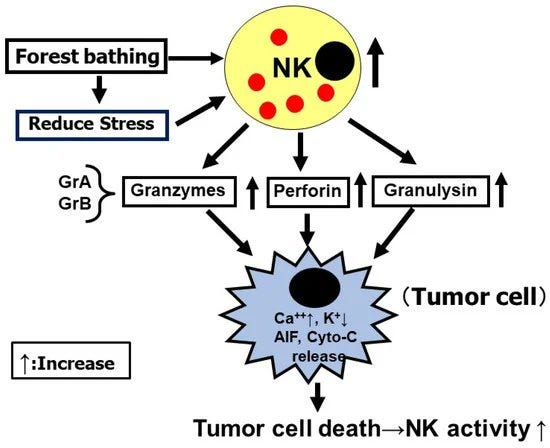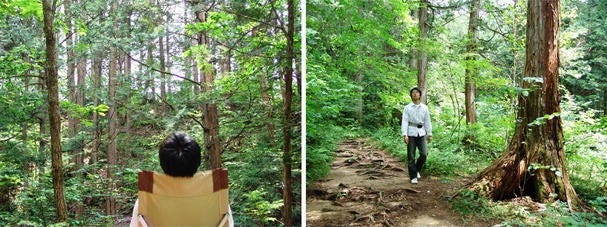A Prescription for Nature: Boost Immunity, Mental and Heart Health, and Reduce Stress.
The Science of How "Forest Bathing" Can Transform Your Health
A growing body of research supports what we've all intuitively known: spending time in nature isn't just enjoyable, it’s therapeutic. Activities like forest bathing (Shinrin-yoku) involving simply immersing yourself in a natural setting, have demonstrated significant health benefits across numerous studies; from stress relief and cardiovascular benefit to enhanced immunity.
Immune System Enhancement
Perhaps the most fascinating finding is nature’s profound impact on our immune systems. A Japanese study observed 12 healthy men (ages 37–55) over a 3-day forest bathing retreat:
Participants walked gently for two hours each day in different forest locations.
Blood samples were collected throughout to assess immune function.
Key Immune Findings:
Natural Killer (NK) cell activity: Increased by ~50% in almost all participants.
Boost in potential anti-cancer proteins: Levels of perforin, granulysin, and granzymes rose significantly.
Durability: Enhanced immune responses persisted up to 7 days after returning to city life.
Urban Control: No similar immune benefits occurred after identical activities in city settings, highlighting the unique role of forest environments.
Mechanism: Phytoncides (volatile compounds emitted by trees such as α-pinene and limonene) are strongly implicated. Laboratory studies support their direct immune-enhancing and stress-reducing effects.
Stress Reduction
In a carefully designed study, 12 healthy men participated in structured forest and city sessions (crossover design), involving:
Quietly viewing scenery (~14 min)
Leisurely walking (~16 min)
Key Findings:
Cortisol (stress hormone): Decreased by ~14% when viewing and ~16% during walking in forest settings compared to urban environments.
Heart Rate: Lowered by ~6% (viewing) and ~4% (walking).
Blood Pressure: Systolic and diastolic pressures modestly but consistently reduced (~2%).
Autonomic Balance: Marked shift toward parasympathetic activity ("rest and digest"), improving by ~56–102%.
Mood: Participants reported significant improvements in tension, depression, anger, fatigue, and confusion, alongside increased vigor.
Takeaway: Just half an hour of calm, mindful forest exposure and walking noticeably decreases stress hormones, gently reduces cardiovascular strain, and improves mood consistently across diverse locations.
Blood Pressure
This reduction in blood pressure from nature exposure has held up in consecutive studies. A systematic review and meta‑analysis compared short bouts of Shinrin‑yoku (walking, sitting, or simply viewing a forest) to matched activities in non‑forest (usually urban) settings. Forest exposure reduced systolic BP by ‑3.15 mmHg on average versus control settings. Participants starting ≥130 mmHg saw a larger SBP reduction (‑6.33 mmHg) than normotensives (‑3.85 mmHg). Heart/pulse rate decreased by ‑3.84 bpm, signaling lower sympathetic drive.
Mental Health Improvements
Forest bathing’s psychological benefits are equally notable. A systematic review of 20 clinical trials (12 RCTs) on guided forest sessions consistently found significant reductions in anxiety across every study, marking it as the most robust outcome. Depression symptoms also improved moderately to strongly, reinforcing nature as a promising complementary mental health tool.
Structured, brief forest experiences significantly reduced symptoms of anxiety and depression. Although the existing studies vary widely, results consistently favor nature-based interventions.
Optimal Nature "Dose"
How much nature exposure is optimal?
Aim for 120 minutes per week (accumulated in sessions of at least 10 minutes) to get maximum benefits of health and well-being.
Anything is better than nothing. Even shorter exposures can yield significant acute benefits, but regular, repeated visits may maximize effects over time.
Why Does Nature Work So Effectively?
Nature’s benefits stem from complex interconnected mechanisms:
Psychological Restoration: Natural environments reduce cognitive fatigue, and provide a break from everyday distractions.
Physiological Regulation: Exposure to natural scents and compounds (e.g., phytoncides) with visual and auditory stimuli lower stress hormones, boost immune response, and activate calming nervous system responses.
Encouraging Healthy Behaviors: Natural settings foster increased physical activity, social interaction, and community engagement.
Practical Tips to Maximize Benefits
Select ideal locations: Dense forests in warmer, more humid climates provide maximum phytoncide exposure, but any blue or green space should confer some benefit compared to indoors.
Fully engage your senses: Limit technology and intentionally observe and enjoy your surroundings.
Take it slow: Spend at least 20 minutes per visit, occasionally pausing to enjoy the experience.
Consistency: Frequent, weekly visits likely compound benefits over time.
Be safe: If you are going to go anywhere alone, make sure friends/family know where. Even though I try not to use it, I bring my phone and leave my location on just in case.
Takeaway
Nature is more than just an escape, it's a scientifically-backed therapy for improving stress levels, mood, cardiovascular health, and immunity. Making nature exposure a routine part of your lifestyle might be one of the simplest, most enjoyable ways to significantly enhance your overall health.
Thanks for reading. Each week, I share practical, evidence-based tools to improve your health, sharpen your focus, and help you perform at your best. If you found this helpful, please consider subscribing to get the next one in your inbox








@https://tynichols.substack.com/